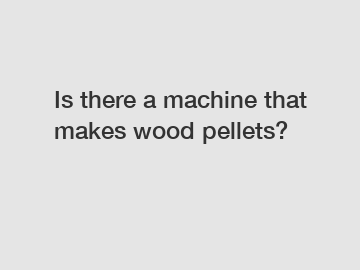Nov. 29, 2023
Machinery
Goto Future Fortune to know more.
Is There a Machine That Makes Wood Pellets?
Wood pellets have gained immense popularity in recent years as a sustainable and efficient alternative to traditional sources of heating and energy. Made from compressed sawdust and other wood waste materials, wood pellets offer a cleaner and more environmentally friendly option for powering pellet stoves and boilers. But how are these pellets produced? Is there a machine specifically designed to manufacture wood pellets? Let's dive into this topic and explore the fascinating world of wood pellet production.

1. The Wood Pellet Manufacturing Process.
To understand whether there is a machine that makes wood pellets, we first need to grasp the manufacturing process. Wood pellet production involves several steps, including biomass preparation, drying, pelletizing, cooling, and packaging. Each of these stages contributes to the overall efficiency and quality of the pellets produced.
2. Biomass Preparation.
The first step in manufacturing wood pellets is the preparation of the biomass feedstock. Various sources, such as sawdust, wood chips, bark, and forest residues, are collected and processed to ensure a consistent and high-quality material for pellet production. The biomass is usually dried to reduce its moisture content, enhancing the efficiency of the pelletizing process.
3. Pelletizing Machine.
Now, let's discuss the pivotal machine used in wood pellet production – the pelletizing machine. This specialized equipment is responsible for compressing the prepared biomass into small cylindrical pellets. The machine applies pressure and heat to the biomass, causing lignin—the natural glue in the wood—to soften and bind the particles together. As a result, compact, dense, and uniform wood pellets are formed.
4. Types of Pelletizing Machines.
There are two primary types of pelletizing machines: flat die and ring die pellet mills. Flat die pellet mills are typically used for small-scale production or for making pellets at home. They consist of a stationary die and a rotating roller that applies pressure to the biomass, forming the pellets. On the other hand, ring die pellet mills are designed for large-scale production and are widely used in commercial pellet plants. These machines feature a rotating die with multiple rollers, which enhances efficiency and throughput.
5. Machine Capacity and Power Source.
The capacity of a wood pellet machine can vary significantly and is often measured in terms of the number of tons it can produce per hour. Small-scale machines can produce several hundred kilograms per hour, while industrial-scale machines can produce several tons per hour. Additionally, the power source for operating these machines can vary, with options including electricity, diesel engines, or even tractors.
6. Additional Steps in Production.
After the pelletizing process, the newly formed wood pellets require further treatment to ensure durability and long shelf life. The pellets are cooled to reduce their temperature and moisture content, enhancing their strength. Finally, the pellets are typically packaged in bags or stored in bulk for further distribution and use.
In conclusion, there is indeed a machine specifically designed for making wood pellets. Wood pellet machines, such as flat die and ring die pellet mills, play a crucial role in the manufacturing process. They compress biomass feedstock under pressure and heat to form the compact and uniform wood pellets we commonly use today. These machines come in various capacities and can be powered by different sources, depending on the scale of production. As the demand for sustainable energy sources continues to rise, wood pellet machines will continue to play a vital role in meeting this demand efficiently and responsibly.
Are you interested in learning more about animal feed coating machine? Contact us today to secure an expert consultation!
If you are interested in sending in a Guest Blogger Submission,welcome to write for us!
All Comments ( 0 )